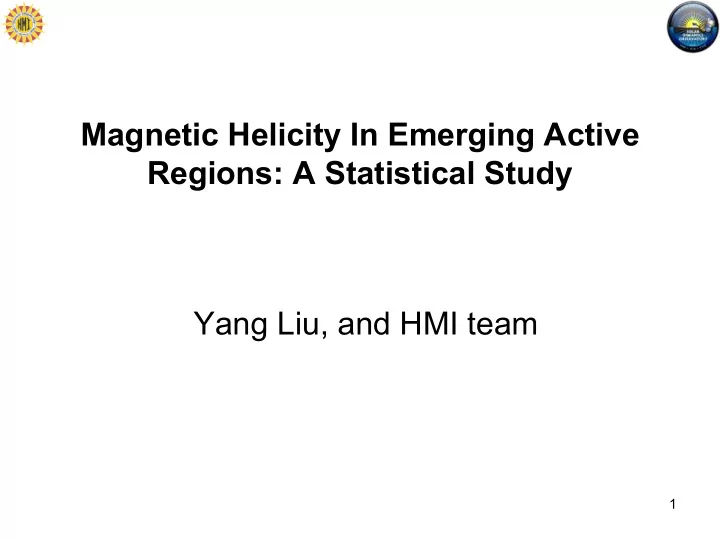

Magnetic Helicity In Emerging Active Regions: A Statistical Study Yang Liu, and HMI team 1
Topics of this work • Study magnetic helicity in emerging active regions; • Examine the so-called ``hemisphere rule’’, i.e., ARs in northern hemisphere has nagetive helicity, and in southern hemisphere positive helicity; • Explore relationship between magnetic helicity and solar transients in ARs. 2
Motivation • How an active regions builds up its helicity is still not clear; • Hemisphere rule is weak when study the current helicity of active regions in solar cycle 22 (Pevtsov et al. 1995; Bao et al. 1998), but no systematic studies for cycles 23-24; • Possible correlation between AR-helicity and solar transients is explored recently (e.g., LaBonte et al. 2007). 3
Methodology • Select emerging active regions; • Compute helicity flux across solar surface (photosphere in this work); • Integrate the flux over time to estimate total helicity accumulated in the corona. The integral starts at the very beginning of AR’s emergence. 4
Calculation of helicity flux Helicity flux across the photospher e : ( ) ( ) ⎛ ⎞ dH ∫ ∫ = × • − × • ⎜ ⎟ 2 A B v ds 2 A v B ds p h n p h n dt ⎝ ⎠ photo photo photospher e B h, B n [obs], and V h, V n [obs + DAVE4VM (Schuck 2008)] 5
Calculation of helicity flux (cont) • However, currently we don’t have enough vector magnetic field data that allow to carry out a statistical study. Thus we use line-of- sight field data instead, using the Demoulin & Berger’s model (2003). This model allows to estimate total helicity flux using time- series line-of-sight magnetograms only. Study shows that the helicity flux computed from this model can recover ~90% of total flux. 6
Demoulin & Berger’s model (2003)—DB03 model Demoulin and Berger (2003) proposed that, = − u v v B / B , h z h z where, u is the horizontal velocity derived by trackin g the photospher ic footpoints of flux tubes . In this way, helicity flux across the photospher e can be re - wrotten as, ( ( ) ( ) ) ( ) ⎛ ⎞ dH ∫ ∫ = × • − • = − × • ⎜ ⎟ 2 A B v A v B ds 2 A u B ds . p h z p h z p z ⎝ dt ⎠ photospher e photospher e photospher e 2006) � u Using DAVE (Schuck 7
AR11072 AR11158 8
Results (18 Emerging ARs) AR Period Location Unsigned flux Total helicity remarks Start-stop Lat, lon Mx Mx^2 11072 2010.05.20-2010.05.26 -15, 325 7.00e21 -1.10e42 No flares 11112 2010.10.14-2010.10.18 -18,203 5.50e21 3.10e40 No flares 11117 2010.10.23-2010.10.27 20,56 1.50e22 1.60e42 C flares 11123 2010.11.10-2010.11.13 -23,191 4.00e21 7.64e41 C flares 11124 2010.11.11-2010.11.16 13,172 1.37e22 -4.79e41 No flares 11126 2010.11.14-2010.11.19 -31,107 6.58e21 -3.06e41 NO flares 11130 2010.11.28-2010.12.02 13,329 1.04e22 -1.86e42 C flares 11141 2010.12.30-2011.01.03 35,269 4.91e21 -2.73e41 C flares 11149 2011.01.21-2011.01.23 17, 344 9.96e21 1.86e42 C flares 11150 2011.01.29-2011.02.02 -20,334 8.22e21 5.67e41 No flares 11158 2011.02.12-2011.02.17 -20,32 3.10e22 1.05e43 X, M, C flares 11160 2011.02.17-2011.02.22 19,335 8.59e21 1.85e41 C flares 11161 2011.02.15-2011.02.22 12,333 1.58e22 5.61e42 C flares 11175 2011.03.18-2011.03.21 12,332 1.03e22 7.64e41 No Flares 11184 2011.04.02-2011.04.07 16,112 1.11e22 5.12e42 No flares 11199 2011.04.25-2011.04.29 20,188 1.06e22 2.60e41 No flares 11214 2011.05.13-2011.05.19 -24,275 7.65e21 3.42e41 No flares 11242 2011.08.28-2011.07.01 17,55 5.66e21 5.75e41 No flares
Results (18 Emerging ARs) • 7 ARs in southern hemisphere, 11 ARs in northern hemisphere; • 5 ARs have negative helicity, 13 ARs have positive helicity; • 8 ARs obey the hemisphere rule (44%); 10 ARs are opposite to the rule (56%); • 71% ARs in southern hemisphere obey the hemisphere rule; 27% ARs in northern hemisphere are opposite to the rule. 10
Distribution of Emerging ARs • Size of symbol is proportional to unsigned flux of the AR. 11
Distribution of helicity in ARs • Size of symbol is proportional to the total helicity in an AR. 12
Distribution of current helicity for cycle 22. Pevtsov et al. (1995) for studying distribution of current helicity in ARs. 1. Using IVM vector data from 1988 to 1994. In total 69 ARs are studied; 2. Compute linear force-free alpha by minimizing the difference between linear-force-free field and observed field (transverse component); 3. 76% ARs in northern hemisphere obey hemisphere rule, 69% ARs in southern hemisphere obey the hemisphere rule. 13
Distribution of current helicity in cycle 22 Bao & Zhang (1998) 1. Data from Huairou from 1988-1998; 2. In total 422 ARs are used for this study; 3. 84% ARs in north hemisphere obey hemisphere rule; 81% ARs in south hemishpere obey the rule. 14
Helicity versus magnetic flux • A linear fit to data yields: Helicity = 2.17e41 + 0.044 * Flux^2 AR11158 15
LaBonte et al (2007) 16
Summary • We study 18 emerging active regions in early phase of solar cycle 24. It is found that (1) 72% active regions have positive helicity; (2) 56% ARs are against the hemisphere rule; (3) ratio of |helicity| versus Flux^2 is about 0.044, if fit to the data from all 18 ARs. 17
Recommend
More recommend